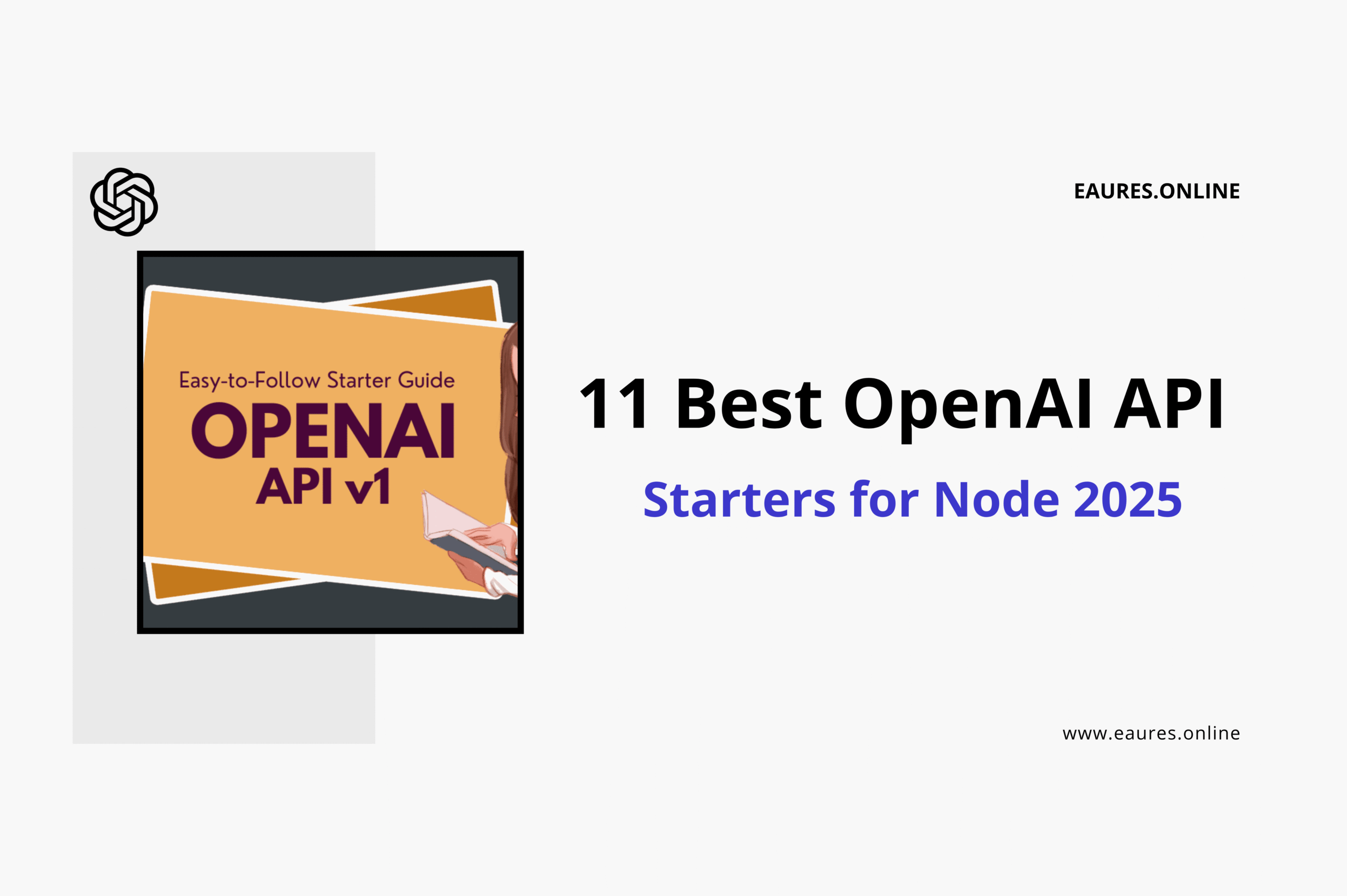Table of Contents
11 Best OpenAI API Starters for Node 2025
Why the Best OpenAI API Starters for Node matter in 2025
Shipping AI features is no longer a moonshot—it’s table stakes. Whether you’re building an internal copilot, a customer‑facing chat assistant, or generative data workflows, choosing from the Best OpenAI API Starters for Node determines how quickly you reach production, how reliable your app feels, and how safely you operate at scale. A great starter doesn’t just “call an API.” It bakes in TypeScript types, streaming UX, error handling, token accounting, environment management, and deployment patterns that survive real traffic.
If you’re new to the platform, the official OpenAI API overview and the detailed API reference introduction will help you understand core primitives before you pick a template. For Node developers, the best starters pair these primitives with ergonomic frameworks—Next.js, Express, Fastify, NestJS, Remix, SvelteKit, Hono, or Serverless—so you can focus on product, not plumbing.

How we evaluated the Best OpenAI API Starters for Node
Criteria that separate a quick demo from a production‑ready starter
- Speed to first token: Starters that implement server‑sent events or web streams feel snappy in UI. We favored templates that mirror the streaming patterns demonstrated in the OpenAI platform docs.
- Type safety & DX: First‑class TypeScript, linting, environment schema checks, and editor autocompletion cut bugs and speed up iteration.
- Security & compliance: Sensible defaults for API key storage, CORS, rate limiting, and logging reduce risk.
- Deployment clarity: The best options provide one‑command deployment to Vercel, Cloudflare Workers, or AWS—plus guidance for staging vs. prod.
- Extensibility: Clear folders for routes, tools, prompt logic, and evaluation help teams scale features—especially when you evolve beyond a single chat endpoint.
- Observability: Basic telemetry (latency, token usage, errors) is not a “nice to have.” It’s how you control cost and catch regressions.
- Docs & ecosystem: We prioritized starters backed by authoritative sources, including the OpenAI docs hub and reputable framework documentation.
Quick setup for any Node‑based OpenAI starter
Before you choose one of the Best OpenAI API Starters for Node, handle these fundamentals:
- Provision credentials by creating a key from your OpenAI account dashboard. Store it as an environment variable (
OPENAI_API_KEY) rather than committing it to source. - Lock a Node version that your framework supports; consult the current Node.js documentation and use
nvmorvoltato avoid “works on my machine.” - Review the API surface you’ll call most (responses, chat, embeddings, images, structured output) in the API reference introduction.
- Decide your runtime (serverful vs. serverless vs. edge). Make that explicit in your starter choice to minimize rewrites later.
- Plan deployment early. If you’re shipping to Vercel, this step‑by‑step guide to deploy LLM apps on Vercel for 2025 covers AI SDK, gateways, rate limits, cron, storage, and streaming in one workflow.
The 11 Best OpenAI API Starters for Node 2025
Each pick below includes what it’s best for, what you get out of the box, and how to take it live fast. Where useful, we link directly to high‑authority docs or example repos.
1) OpenAI Quickstart for Node (Official)
If you want the most canonical baseline, start with the official openai-quickstart-node repository. It walks through environment configuration, minimal routes, and a clean server‑side call to the API—perfect as a teaching tool or seed for a microservice.
What you get
- A minimal Node/Express setup with clear
.envuse and safe key handling. - Straightforward examples that track closely with the OpenAI API docs.
When to choose it
- You need a verified reference implementation that won’t surprise junior teammates.
- You plan to stitch this into a larger monorepo or microservice architecture.
Fast track
- Clone the repo.
- Add
OPENAI_API_KEYto.env. - Run, call, and adapt endpoints.
- Deploy to your host of choice.
Scaling pointers
- Pair with a front‑end framework if you want streaming chat UX.
- Add request validation and token‑usage logging early.
2) Vercel AI SDK + Next.js Chatbot Starter
For teams who want a polished chat interface, the Vercel AI SDK provides ergonomic hooks and components that handle streaming, React Server Components, and tool invocation patterns. The official SDK docs at the Vercel AI SDK site show how to wire prompts, server actions, and streaming in minutes, and the Next.js template gives you a high‑quality UI out of the box.
What you get
- Production‑grade streaming UX with React Server Components.
- One‑command deploy to Vercel + environment variable scaffolding.
When to choose it
- You’re building assistants, retrieval‑augmented UI, or multi‑step tools.
- You value “batteries included” developer experience over bare metal control.
Extra credit
- For deployment choreography in 2025, see the detailed guide on production‑speed Vercel workflows for LLM apps.
3) Cloudflare Workers + Hono + OpenAI (Edge)
If latency and global footprint matter, an edge‑first starter with Hono or native Workers is ideal. The Hono framework is tiny and fast, and Cloudflare’s edge network helps your chat tokens arrive sooner for worldwide users. Reference the Cloudflare Workers documentation and the Hono framework docs to bootstrap an edge handler that streams responses efficiently.
What you get
- Ultra‑low overhead, fast cold starts, and edge‑native streaming.
- Simple route handlers and middleware for CORS and auth.
When to choose it
- You serve users across multiple regions.
- You prefer “just enough” framework to keep bundles small.
Tips
- Keep secrets in Cloudflare KV or Secrets.
- Monitor logs for rate limits and retry intelligently.

4) NestJS + OpenAI Module Starter
NestJS gives you an opinionated architecture (modules, providers, controllers) with first‑class TypeScript. It’s a strong pick for larger teams that value structure and testability. Pair Nest’s dependency injection with the OpenAI SDK and use the NestJS official documentation to scaffold modules for chat, embeddings, or file workflows.
What you get
- Clean separation of concerns: controllers for HTTP, providers for services.
- Declarative guards, interceptors, and pipes for validation and security.
When to choose it
- Enterprise apps with complex domains or multiple AI services.
- Teams that need consistent testing and CI patterns.
Bonus
- Consider centralizing prompts and tests with a prompt framework; this guide to the strongest prompts for LLMs in 2025 can standardize styles and guardrails across modules.
5) Express.js Minimalist OpenAI Starter
Sometimes you just want tiny and familiar. Express is still the most widely recognized Node web framework, and you can craft a lean starter with a single /api/chat endpoint, CORS, and a streaming helper. See the Express official site for middleware patterns that keep your code small and readable.
What you get
- Minimal footprint, easy mental model.
- Quick porting into existing monoliths.
When to choose it
- You’re prototyping and want to minimize framework complexity.
- You’re integrating AI endpoints into a legacy Express app.
Notes
- Add a typed layer (Zod or TypeScript interfaces) to reduce runtime errors.
- Implement request quotas early to manage API cost.
6) Fastify + pino Logging Starter
Fastify offers a modern alternative to Express with better performance characteristics and structured logging via pino. For AI services that need observability, this is a compelling baseline. Start with the Fastify documentation and pair it with the OpenAI SDK for JSON mode, function‑like tools, and streaming handlers.
What you get
- High throughput routing and JSON‑first ergonomics.
- Built‑in pino logs for latency, status codes, and payload sizes.
When to choose it
- You anticipate bursty traffic or heavy concurrency.
- You want structured logs for auditing tokens and errors.
Pro tip
- Emit per‑request token counts to pino; aggregate later for cost reports.
7) Remix + AI Chat Starter
Remix leans into “web fundamentals,” which translates into predictable data loading and optimistic UI updates. Remixed with the AI SDK or the OpenAI SDK, you can build a gracefully progressive chat and tool‑use interface. Use the Remix documentation to structure loaders/actions for your AI routes.
What you get
- File‑based routes with predictable server handling.
- Solid fetch semantics perfect for AI form actions and streaming.
When to choose it
- You want to keep server and UI logic close without framework sprawl.
- Progressive enhancement matters for your user base.
8) SvelteKit + OpenAI Starter
If you prefer Svelte’s minimal reactivity model, SvelteKit makes it easy to wire endpoints and stream tokens to a simple UI. The SvelteKit docs show how to create server routes and optimize payloads—handy for chat and rich tool‑use UIs without React complexity.
What you get
- Tiny bundles and excellent perceived performance.
- Straightforward server routes for OpenAI API calls.
When to choose it
- You want crisp, fast UX with minimal boilerplate.
- SSR + streaming are must‑haves with low client JS.
9) Serverless Framework (AWS Lambda) Node Starter
For teams betting on AWS primitives, a Serverless starter keeps cost predictable and scale elastic. Pair Lambda and API Gateway for your AI endpoints and use the Serverless Framework documentation to deploy with one command. For data pipelines (embeddings, analytics), combine Lambdas with queues and scheduled triggers.
What you get
- Pay‑for‑what‑you‑use economics plus straightforward blue/green deploys.
- Flexibility to add cron, queues, and retries around AI calls.
When to choose it
- You need granular IAM controls and VPC integration.
- You’re building batch or event‑driven AI jobs alongside chat.
Bonus
- If your app requires data crunching, this end‑to‑end guide to automating data analysis with Python + LLMs can complement your Node services with scheduled analytics.

10) T3 Stack (Next.js + tRPC + Prisma) + OpenAI
The T3 philosophy—type safety and simplicity—pairs nicely with AI features, especially when you need authenticated procedures and database persistence. Use the create‑t3‑app documentation to scaffold your app, then expose AI methods via tRPC routers. Combine Prisma for prompt logs, conversation histories, or tool outputs.
What you get
- End‑to‑end TypeScript, tRPC procedures, and Prisma schema.
- A clear home for auth, rate limits, and per‑user quotas.
When to choose it
- You expect to store structured AI outputs or conversation state.
- You want type‑safe client calls with minimal boilerplate.
11) Electron + Node Desktop Starter (Offline‑friendly UI)
If your users need a desktop app—think internal copilots with local files—Electron provides a Chromium shell with Node access. Use the Electron documentation to scaffold the shell, call OpenAI from a secure main process, and stream results into a desktop UI. Bundle secrets properly and gate network calls by user plan.
What you get
- Cross‑platform desktop with Node integration.
- Access to local files and system integrations.
When to choose it
- You need native‑feeling copilots that work with local resources.
- Offline‑first UX matters with deferred sync.
Comparison: Best OpenAI API Starters for Node at a glance
| Starter | Framework/Runtime | Streaming UX | Auth/Env Defaults | Serverless/Edge Ready | Ideal Use Case |
|---|---|---|---|---|---|
| OpenAI Quickstart (Official) | Express/Node | Basic | .env + minimal | Serverful or serverless | Canonical baseline, teaching |
| Vercel AI SDK + Next.js | Next.js on Vercel | Excellent | Built‑in env + deploy | Serverless on Vercel | Chat apps, assistants |
| Cloudflare + Hono | Workers (Edge) | Excellent | Secrets + middleware | Edge native | Global, low‑latency apps |
| NestJS Module Starter | NestJS | Good | DI + guards | Serverful or Lambda | Enterprise services |
| Express Minimal | Express | Good | Middleware | Any | Retrofits, monoliths |
| Fastify + pino | Fastify | Good | Structured logs | Any | High throughput APIs |
| Remix Chat Starter | Remix | Good | Loaders/actions | Any | Progressive web UX |
| SvelteKit Starter | SvelteKit | Good | Server routes | Any | Minimal client JS |
| Serverless Framework | AWS Lambda | Good | IAM + stages | Serverless | Pipelines, batch |
| T3 + tRPC + Prisma | Next.js/T3 | Good | Auth + types | Vercel or serverful | Type‑safe SaaS |
| Electron Desktop | Electron/Node | App‑local | Secure main proc | Desktop | Local copilots |
Implementation best practices to keep your Node starter production‑ready
Guardrails and prompt operations
Don’t let prompts sprawl. Centralize them with type‑checked variables, version them, and test for regressions. A practical, evaluation‑first method is outlined in this guide to the strongest prompts for LLMs in 2025, which offers templates, guardrails, and quality checks you can drop into any of the Best OpenAI API Starters for Node.
Input validation and structured output
Validate inputs at the edge of your app using Zod or class‑validator (NestJS). When you need structured results (JSON), align your schema with the shapes in the OpenAI API reference. This avoids brittle string parsing and lets you enforce data contracts.
Observability, cost control, and rate limits
Emit per‑request telemetry: model, latency, tokens in/out, user ID, and success/failure. Track these fields in logs (pino) or a metrics backend. Configure quotas (per minute/hour/day) and exponential backoff for 429s. For deployment‑time rate‑limit orchestration, the Vercel workflow guide on production‑grade limits and streaming is useful even if you don’t ship on Vercel.
Secure key management
Never expose OPENAI_API_KEY to the browser. Keep calls server‑side, use platform secrets (Vercel env vars, Cloudflare Secrets, AWS Secrets Manager), and rotate keys periodically. If you must call from the client, proxy requests through a signed, short‑lived token.
Streaming that feels instant
Users equate “fast” with “trustworthy.” Use readable streams or server‑sent events so the UI shows partial tokens quickly. The AI SDK’s streaming primitives, plus patterns from the OpenAI platform docs, map directly onto nearly all of the Best OpenAI API Starters for Node.
Caching and RAG
Cache expensive, deterministic calls (embeddings for the same text) and avoid duplicate work. If you’re adding retrieval, keep your RAG pipeline testable. For teams blending Python data crunching with Node services, the guide on automating data analysis with Python + LLMs pairs well with Serverless and NestJS starters.
Testing and CI
Snapshot tests for prompts, schema validation for JSON outputs, and smoke tests for critical endpoints will catch regressions early. Run lightweight evals on every PR to ensure your assistant stays consistent.
Model agility & fallbacks
Even if you’re standardizing on OpenAI, design for graceful model changes. When you need an internal comparison or a fallback to open models, this 2025 breakdown of Llama 3 vs. Mistral helps you reason about performance, licensing, and cost—useful context when you’re designing abstractions in your Node code.
Curated walkthroughs and references
- If you prefer video, this short primer—an OpenAI API quickstart walkthrough on YouTube—pairs nicely with the official OpenAI quickstart repo for Node.
- For deeper platform details, keep the OpenAI API reference and the broader documentation hub open while you adapt any of the Best OpenAI API Starters for Node.

FAQ: choosing among the Best OpenAI API Starters for Node
Which Node starter is best for a first production chat app?
If you want fast UI polish and clean deployment, the Vercel AI SDK + Next.js starter strikes the best balance. It provides streaming, React Server Components, and prebuilt patterns that many teams end up re‑implementing anyway.
What if I need global low latency with strict cost controls?
Choose an edge‑first template like Cloudflare Workers + Hono. Complement it with structured logs and quotas so 429s don’t degrade UX. Use secrets and KV for safe key storage.
Which starter is most enterprise‑friendly?
NestJS is built for larger codebases. Its DI and module boundaries are intuitive, and its testability offsets complexity. Add guards, interceptors, and class‑validator to keep your API robust.
Can I add RAG or workflows later?
Absolutely. All Best OpenAI API Starters for Node can absorb vector search, tools, and workflow orchestration. Make sure to version prompts and introduce evals before you scale user traffic.
How do I keep token costs predictable?
Log token usage per request and per model. Enforce quotas, cache embeddings, and adjust temperature/top‑p to control variability. Create budget alarms that page your ops channel before a spike becomes a bill.
Do I need TypeScript for these starters?
You don’t need it, but you’ll want it. TypeScript catches subtle contract errors—especially with structured outputs and tool definitions—and it improves autocompletion across your stack.
Conclusion
The Best OpenAI API Starters for Node help you move from a promising prototype to a scalable, trustworthy AI product. Choose the path that matches your runtime and team culture: Next.js with AI SDK for speed, Workers + Hono for global edge performance, NestJS for enterprise structure, or Serverless for elastic workloads. Layer in type‑safe prompts, strong observability, and disciplined deployment practices, and you’ll be shipping AI features with confidence all year long.
For authoritative references while you build, keep the OpenAI API overview, the API reference introduction, and the broader docs hub at your fingertips—and treat the OpenAI quickstart for Node as your canonical baseline.





Здравствуйте! Вот-вот наступит 23 февраля, и многие озадачиваются, как порадовать с 23 февраля команду и друзей креативно и с юмором. Если разыскиваете решения для необычного поздравления с 23 февраля коллегам, сценарии или просто смешные слова — предлагаю заглянуть сюда [url=https://holiday-for-you.ru/]прикольные смс с новым годом 2026[/url] . Там огромное количество практичного, от мессенджей до сценариев, которые наверняка обеспечат мероприятие ярким.
Дополнительно, уже стоит подумать и о презентах воспитателям на 8 марта. Если затрудняетесь, что выбрать в подарок воспитателям на 8 марта или разыскиваете уникальное поздравление с профессиональным праздником (а он в какой день? — 27 сентября), то подобным же образом обнаружите много вариантов на том же интернет-площадке. Поскольку выбрать презент или поздравление далеко не всегда очевидно, в частности когда мечтаешь сделать приятное всерьез. Заодно, там же можно найти материалы о других праздниках, например, когда день всех мам в 2026 году, чтобы вовремя подготовиться.